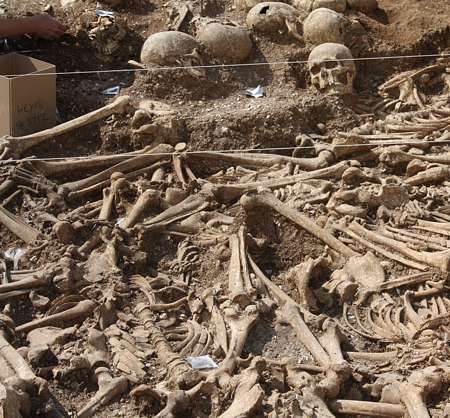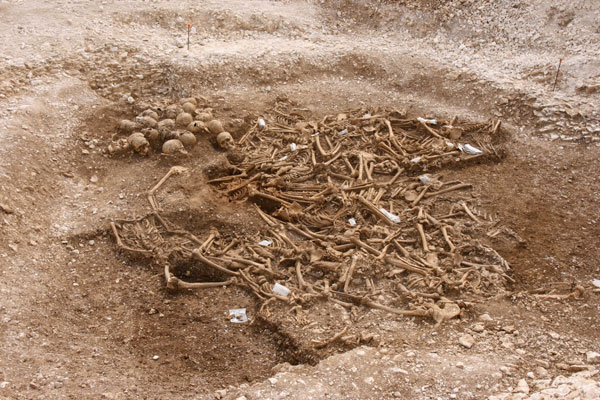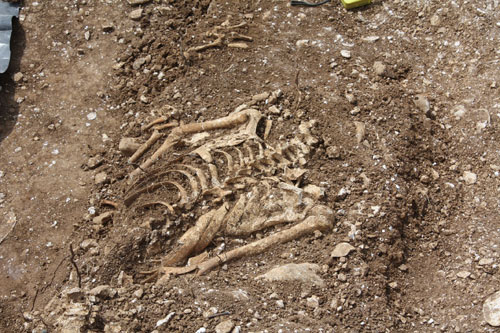Medieval History
 Fifty-one decapitated skeletons found in a burial pit in Dorset, England were those of Scandinavian Vikings, scientists say.
Fifty-one decapitated skeletons found in a burial pit in Dorset, England were those of Scandinavian Vikings, scientists say.
The site was discovered in June 2009 during building work on the 'Olympic Highway' by Dorset County Council; a relief road built to ease transport congestion for the London 2012 Olympic Games.
Archaeologists, led by David Score of Oxford Archaeology, unearthed at least 51 decapitated individuals. Many of the executed men suffered multiple wounds, inflicted by a sharp-bladed weapon, to the skull and jaw as well as the upper spine ? indicating that their execution was by decapitation.
The archaeologists now believe the men were probably executed by local Anglo-Saxons in front of an audience sometime between AD 910 and AD 1030.
Initially, it was thought the burial site dated from the Iron Age (from 800 BC) to early Roman times (from AD 43) after examining pottery in the pit, later identified as a Roman quarry. Radiocarbon dating later revealed they were from the Saxon period.
The Anglo Saxons were increasingly falling victim to Viking raids and eventually the country was ruled by a Danish king. The mass grave is one of the largest examples of executed foreigners buried in one spot.
Samples of 10 remains were identified as Scandinavian by Dr Jane Evans and Carolyn Chenery, of NERC Isotope Geosciences Laboratory, part of the British Geological Survey, based in Nottingham.
Their work has revealed that the men had scattered Scandinavian origins, with one even thought to be from north of the Arctic Circle.

Project manager David Score said: "To find out that the young men executed were Vikings is a thrilling development. Any mass grave is a relatively rare find, but to find one on this scale, from this period of history, is extremely unusual."
He added that without analysing all the bodies it was impossible to know for certain that all the skeletons were those of Vikings, but it was possible to make a "strong inference".
Tooth enamel provides a time capsule of information about a person?s childhood environment. The oxygen isotope composition of the enamel is related to the composition of drinking water and this, in turn, is controlled by the climate.
The Scandinavian countries of Norway and Sweden have a colder climate that Britain leading to a distinct and different isotope signature in tooth enamel.
The individuals measured in this study had oxygen isotope tooth enamel values that were ?too cold? to be British and consistent with Scandinavian origin.
?This is an amazing discovery. It is the largest group people of foreign origin that we have identified using isotopes,? said Dr Jane Evans.
Strontium isotopes, which relate a person to the land on which they were raised, show the men came from several different places within Scandinavia.
?This is one of the largest Viking-age assemblages we have worked on. Up until now there have only been one or two confirmed Scandinavians of this period, found in the UK, using isotope techniques.? added Carolyn Chenery.
Carbon and nitrogen isotope analysis of tooth dentine supports the fact they had a meat-rich diet typical of Scandinavians of the same period.
The archaeologists believe the men were stripped naked either before being killed, or before being buried, because there was no evidence of clothing, such as pins or toggles. Most of them were in their late teens to early 20s, with a handful in their 30s.

Leader of Dorset County Council Angus Campbell said: "We have a tremendous historic environment here in Dorset but we never would have dreamed of finding a Viking war grave.
"We've had prehistoric finds from the investigation on Ridgeway before construction work started and we were thrilled by evidence of an Iron Age settlement found on Southdown Ridge during the earthworks. The burial pit took us all by surprise and its story gets more fascinating as the analysis goes on."
Many of the executed men suffered multiple wounds - inflicted by a sharp bladed weapon - to the skull and jaw as well as the upper spine, all thought to relate to the process of decapitation.
A scarce selection of other wounds have been found on some men, including a cut to the pelvis, blows to the chest and stomach and defensive injuries to the hands.
There are also two examples of healed fractures, which are unlikely to have been medically treated. In one case this has led to the right leg being a good 5cm shorter than the left. These individuals would have both had pronounced limps.
It is hoped further evidence about the demographic make-up, lifestyles, activities, general health and diets of the warriors will come to light as the analysis continues.
Please also see our earlier article: Medieval Massacre Site Found in Dorset
- Archaeological Research Reveals New Insights About The Vikings In Wales
Recent excavations by archaeologists from the National Museum Wales at the Viking age settlement of Llanbedrgoch on the east side of Anglesey have shed important new light on the impact of Anglo-Saxon and Viking-age worlds operating around the Irish...
- Viking Mass Grave Linked To Elite Killers Of The Medieval World
A crew of Viking mercenaries ? some of the fiercest and most feared killers in the medieval world ? could be the occupants of a mysterious mass grave in the south of England, according to a new theory. The intriguing hypothesis is being put forward in...
- Tests Confirm That Bones Are From A Medieval Queen
Bones excavated in Magdeburg Cathedral in 2008 are those of Saxon Princess Eadgyth who died in AD 946, experts at the University of Bristol confirmed today. The crucial scientific evidence came from the teeth preserved in the upper jaw. The bones are...
- Brain Surgery Was Performed In Ninth-century Ireland
Remarkable new details were revealed this week from the discovery of a medieval grave in County Donegal in Ireland. One of the most notable is that archaeologists have come across the remains of a young woman buried around the year 800 AD who underwent...
- Teeth Of Columbus?s Crew Flesh Out Tale Of New World Discovery
The adage that dead men tell no tales has long been disproved by archaeology. Now, however, science is taking interrogation of the dead to new heights. In a study that promises fresh and perhaps personal insight into the earliest European visitors to...
Medieval History
Victims of Medieval Massacre Site were Vikings

The site was discovered in June 2009 during building work on the 'Olympic Highway' by Dorset County Council; a relief road built to ease transport congestion for the London 2012 Olympic Games.
Archaeologists, led by David Score of Oxford Archaeology, unearthed at least 51 decapitated individuals. Many of the executed men suffered multiple wounds, inflicted by a sharp-bladed weapon, to the skull and jaw as well as the upper spine ? indicating that their execution was by decapitation.
The archaeologists now believe the men were probably executed by local Anglo-Saxons in front of an audience sometime between AD 910 and AD 1030.
Initially, it was thought the burial site dated from the Iron Age (from 800 BC) to early Roman times (from AD 43) after examining pottery in the pit, later identified as a Roman quarry. Radiocarbon dating later revealed they were from the Saxon period.
The Anglo Saxons were increasingly falling victim to Viking raids and eventually the country was ruled by a Danish king. The mass grave is one of the largest examples of executed foreigners buried in one spot.
Samples of 10 remains were identified as Scandinavian by Dr Jane Evans and Carolyn Chenery, of NERC Isotope Geosciences Laboratory, part of the British Geological Survey, based in Nottingham.
Their work has revealed that the men had scattered Scandinavian origins, with one even thought to be from north of the Arctic Circle.

Project manager David Score said: "To find out that the young men executed were Vikings is a thrilling development. Any mass grave is a relatively rare find, but to find one on this scale, from this period of history, is extremely unusual."
He added that without analysing all the bodies it was impossible to know for certain that all the skeletons were those of Vikings, but it was possible to make a "strong inference".
Tooth enamel provides a time capsule of information about a person?s childhood environment. The oxygen isotope composition of the enamel is related to the composition of drinking water and this, in turn, is controlled by the climate.
The Scandinavian countries of Norway and Sweden have a colder climate that Britain leading to a distinct and different isotope signature in tooth enamel.
The individuals measured in this study had oxygen isotope tooth enamel values that were ?too cold? to be British and consistent with Scandinavian origin.
?This is an amazing discovery. It is the largest group people of foreign origin that we have identified using isotopes,? said Dr Jane Evans.
Strontium isotopes, which relate a person to the land on which they were raised, show the men came from several different places within Scandinavia.
?This is one of the largest Viking-age assemblages we have worked on. Up until now there have only been one or two confirmed Scandinavians of this period, found in the UK, using isotope techniques.? added Carolyn Chenery.
Carbon and nitrogen isotope analysis of tooth dentine supports the fact they had a meat-rich diet typical of Scandinavians of the same period.
The archaeologists believe the men were stripped naked either before being killed, or before being buried, because there was no evidence of clothing, such as pins or toggles. Most of them were in their late teens to early 20s, with a handful in their 30s.

Leader of Dorset County Council Angus Campbell said: "We have a tremendous historic environment here in Dorset but we never would have dreamed of finding a Viking war grave.
"We've had prehistoric finds from the investigation on Ridgeway before construction work started and we were thrilled by evidence of an Iron Age settlement found on Southdown Ridge during the earthworks. The burial pit took us all by surprise and its story gets more fascinating as the analysis goes on."
Many of the executed men suffered multiple wounds - inflicted by a sharp bladed weapon - to the skull and jaw as well as the upper spine, all thought to relate to the process of decapitation.
A scarce selection of other wounds have been found on some men, including a cut to the pelvis, blows to the chest and stomach and defensive injuries to the hands.
There are also two examples of healed fractures, which are unlikely to have been medically treated. In one case this has led to the right leg being a good 5cm shorter than the left. These individuals would have both had pronounced limps.
It is hoped further evidence about the demographic make-up, lifestyles, activities, general health and diets of the warriors will come to light as the analysis continues.
Please also see our earlier article: Medieval Massacre Site Found in Dorset
- Archaeological Research Reveals New Insights About The Vikings In Wales
Recent excavations by archaeologists from the National Museum Wales at the Viking age settlement of Llanbedrgoch on the east side of Anglesey have shed important new light on the impact of Anglo-Saxon and Viking-age worlds operating around the Irish...
- Viking Mass Grave Linked To Elite Killers Of The Medieval World
A crew of Viking mercenaries ? some of the fiercest and most feared killers in the medieval world ? could be the occupants of a mysterious mass grave in the south of England, according to a new theory. The intriguing hypothesis is being put forward in...
- Tests Confirm That Bones Are From A Medieval Queen
Bones excavated in Magdeburg Cathedral in 2008 are those of Saxon Princess Eadgyth who died in AD 946, experts at the University of Bristol confirmed today. The crucial scientific evidence came from the teeth preserved in the upper jaw. The bones are...
- Brain Surgery Was Performed In Ninth-century Ireland
Remarkable new details were revealed this week from the discovery of a medieval grave in County Donegal in Ireland. One of the most notable is that archaeologists have come across the remains of a young woman buried around the year 800 AD who underwent...
- Teeth Of Columbus?s Crew Flesh Out Tale Of New World Discovery
The adage that dead men tell no tales has long been disproved by archaeology. Now, however, science is taking interrogation of the dead to new heights. In a study that promises fresh and perhaps personal insight into the earliest European visitors to...
